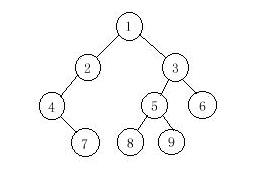hdu 1710 Binary Tree Traversals
2016-12-27 21:33
337 查看
[align=left]Problem Description[/align]
A binary tree is a finite set of vertices that is either empty or consists of a root r and two disjoint binary trees called the left and right subtrees. There are three most important ways in which the vertices of a binary tree can
be systematically traversed or ordered. They are preorder, inorder and postorder. Let T be a binary tree with root r and subtrees T1,T2.
In a preorder traversal of the vertices of T, we visit the root r followed by visiting the vertices of T1 in preorder, then the vertices of T2 in preorder.
In an inorder traversal of the vertices of T, we visit the vertices of T1 in inorder, then the root r, followed by the vertices of T2 in inorder.
In a postorder traversal of the vertices of T, we visit the vertices of T1 in postorder, then the vertices of T2 in postorder and finally we visit r.
Now you are given the preorder sequence and inorder sequence of a certain binary tree. Try to find out its postorder sequence.

[align=left]Input[/align]
The input contains several test cases. The first line of each test case contains a single integer n (1<=n<=1000), the number of vertices of the binary tree. Followed by two lines, respectively indicating the preorder sequence and
inorder sequence. You can assume they are always correspond to a exclusive binary tree.
[align=left]Output[/align]
For each test case print a single line specifying the corresponding postorder sequence.
[align=left]Sample Input[/align]
9
1 2 4 7 3 5 8 9 6
4 7 2 1 8 5 9 3 6
[align=left]Sample Output[/align]
7 4 2 8 9 5 6 3 1题意:根据前序和中序写出后序 前序:1 2 4 7 3 5 8 9 6 中序:4 7 2 1 8 5 9 3 6 求出后序:7 4 2 8 9 5 6 3 1首先得知道是如何前序遍历、中序遍历、后序遍历的,自己上网查下,我在这里就不多说了思路:第一步:根据前序可知根节点为1;第二步:根据中序可知4 7 2为根节点1的左子树和8 5 9 3 6为根节点1的右子树;第三步:递归实现,把4 7 2当做新的一棵树和8 5 9 3 6也当做新的一棵树;第四步:在递归的过程中输出后序。代码实现:
A binary tree is a finite set of vertices that is either empty or consists of a root r and two disjoint binary trees called the left and right subtrees. There are three most important ways in which the vertices of a binary tree can
be systematically traversed or ordered. They are preorder, inorder and postorder. Let T be a binary tree with root r and subtrees T1,T2.
In a preorder traversal of the vertices of T, we visit the root r followed by visiting the vertices of T1 in preorder, then the vertices of T2 in preorder.
In an inorder traversal of the vertices of T, we visit the vertices of T1 in inorder, then the root r, followed by the vertices of T2 in inorder.
In a postorder traversal of the vertices of T, we visit the vertices of T1 in postorder, then the vertices of T2 in postorder and finally we visit r.
Now you are given the preorder sequence and inorder sequence of a certain binary tree. Try to find out its postorder sequence.

[align=left]Input[/align]
The input contains several test cases. The first line of each test case contains a single integer n (1<=n<=1000), the number of vertices of the binary tree. Followed by two lines, respectively indicating the preorder sequence and
inorder sequence. You can assume they are always correspond to a exclusive binary tree.
[align=left]Output[/align]
For each test case print a single line specifying the corresponding postorder sequence.
[align=left]Sample Input[/align]
9
1 2 4 7 3 5 8 9 6
4 7 2 1 8 5 9 3 6
[align=left]Sample Output[/align]
7 4 2 8 9 5 6 3 1题意:根据前序和中序写出后序 前序:1 2 4 7 3 5 8 9 6 中序:4 7 2 1 8 5 9 3 6 求出后序:7 4 2 8 9 5 6 3 1首先得知道是如何前序遍历、中序遍历、后序遍历的,自己上网查下,我在这里就不多说了思路:第一步:根据前序可知根节点为1;第二步:根据中序可知4 7 2为根节点1的左子树和8 5 9 3 6为根节点1的右子树;第三步:递归实现,把4 7 2当做新的一棵树和8 5 9 3 6也当做新的一棵树;第四步:在递归的过程中输出后序。代码实现:
//根据前序和中序遍历写出后序遍历
#include<iostream>
using namespace std;
int t1[1001],t2[1001];
void sousuo(int a,int b,int n,int flag)
{
if(n==1)//如果存在左子树或右子树就直接输出
{
printf("%d ",t1[a]);
return ;
}
else if(n<=0)//如果不存在左子树或右子树就返回上一层
return ;
int i;//继续罚分为左子树和右子树
for(i=0;t1[a]!=t2[b+i];i++) ;//找到罚分点也就是根节点
sousuo(a+1,b,i,0);//左子树的遍历
sousuo(a+i+1,b+i+1,n-i-1,0);//右子树的遍历
if(flag==1)//最原始的跟节点
printf("%d",t1[a]);
4000
else//一般的根节点
printf("%d ",t1[a]);
}
int main()
{
int n,i;
while(scanf("%d",&n)!=EOF)
{
for(i=1;i<=n;i++)
scanf("%d",&t1[i]);//t1中存的是前序
for(i=1;i<=n;i++)//t2中存的中序
scanf("%d",&t2[i]);
sousuo(1,1,n,1);
printf("\n");
}
return 0;
}
相关文章推荐
- HDU 1710 Binary Tree Traversals
- hdu 1710:Binary Tree Traversals
- HDU--1710 -- Binary Tree Traversals
- hdu 1710 Binary Tree Traversals
- HDU-1710-Binary Tree Traversals
- hdu 1710 binary tree traversals 二叉树遍历
- hdu 1710 Binary Tree Traversals
- hdu 1710 Binary Tree Traversals
- 【二叉树之遍历的应用】HDU 1710---Binary Tree Traversals
- HDU (1710)Binary Tree Traversals
- HDU 1710 Binary Tree Traversals
- HDU1710——Binary Tree Traversals(二叉树)
- 已知树的前序和中序求后序 hdu 题目1710 Binary Tree Traversals
- 二叉树 遍历 hdu-1710-Binary Tree Traversals
- HDU-1710 Binary Tree Traversals 二叉树遍历
- HDU 1710 Binary Tree Traversals(二叉树)
- HDU 1710 Binary Tree Traversals
- Hdu--1710--Binary Tree Traversals
- HDU 1710 Binary Tree Traversals
- hdu 1710 Binary Tree Traversals
